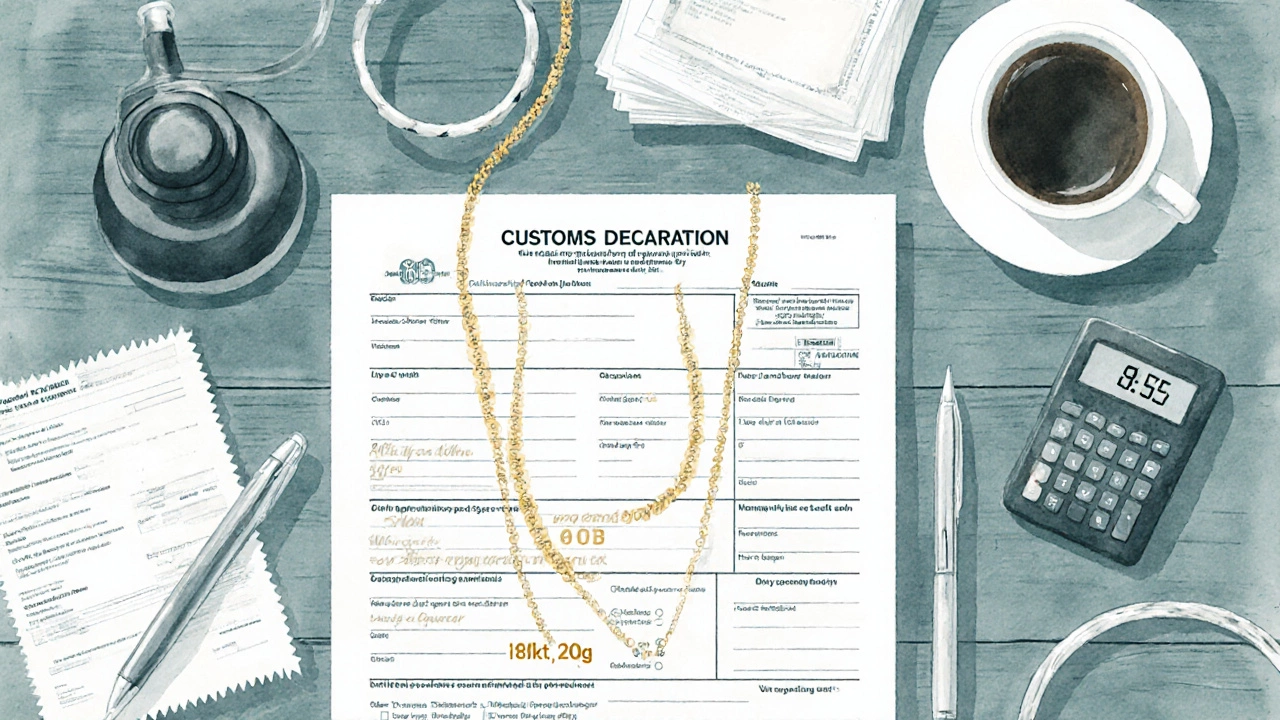Jewelry Declaration Calculator
Check Your Jewelry Declaration Status
Enter your details to see if your jewelry needs to be declared at US Customs.
Declaration Result
Important Information
Returning U.S. Residents: You are allowed a duty-free exemption of up to $800 for items acquired abroad.
Non-Residents: There is no personal exemption; every item with a monetary value must be declared.
Tip Even if below the exemption limit, declare high-value heirlooms to prove ownership and avoid questions later.
Quick Takeaways
- All jewelry you bring into the US must be listed on the customs declaration form if its value exceeds your personal exemption.
- For most travelers the exemption is $800 for returning residents and $0 for non‑residents.
- Declare honestly; failure can lead to fines, seizure, or delayed entry.
- If you’re bringing high‑value pieces, consider using a customs broker and keep receipts.
- Know the duty rates - typically 0‑5% on precious metals and 5‑12% on costume pieces.
Traveling with a box of heirloom necklaces or a suitcase full of diamond rings can feel like a treasure hunt, but the real challenge is figuring out whether the U.S. border guards expect you to shout out the value of each piece. This guide cuts through the red tape and tells you exactly when, how, and why you should declare jewelry at US customs, so you can avoid surprise fees or, worse, a confiscated heirloom.
Understanding U.S. Customs Basics
U.S. Customs and Border Protection (CBP) is the federal agency that enforces import laws, collects duties, and protects the country from prohibited items. When you arrive by air, sea, or land, CBP officers inspect your belongings based on the information you provide on a customs declaration form.
CBP’s primary goal is to ensure that imported goods, including jewelry, comply with valuation, classification, and licensing rules. If your items are correctly declared, the process is quick; if not, you risk delays, additional paperwork, or monetary penalties.
What Counts as Jewelry?
For customs purposes, "jewelry" is any personal accessory made of metal, gemstones, beads, or synthetic materials that is worn for adornment. This includes rings, necklaces, bracelets, earrings, brooches, watches (when worn as an accessory), and even ornamental hair pins. Items that are purely functional, like a metal chain used as a tool, may be classified differently, but the safest bet is to treat any decorative piece as jewelry.
Keep in mind that the material matters for duty rates. Gold jewelry and diamond jewelry typically have lower duty percentages than costume pieces made of base metals or synthetic stones.

When Must You Declare?
The rule of thumb is simple: if the total value of the jewelry you are bringing in exceeds your personal exemption, you must declare it.
Two key scenarios trigger a declaration:
- Returning U.S. residents: You are allowed a duty‑free exemption of up to $800 for items acquired abroad. Anything above that must be listed.
- Non‑residents or visitors: There is no personal exemption; every item with a monetary value must be declared, even if the total is well under $800.
Even if the value is below the exemption, you may still want to declare high‑value heirlooms to prove ownership and avoid questions later. Undeclared items can be seized, and you may face a fine of up to 10% of the item's value, plus possible criminal charges for fraud.
How to Fill Out the Customs Declaration Form
Every arriving passenger receives a Customs declaration form (Form6059B). The form asks for a general description of goods and their total value. Here’s a step‑by‑step checklist:
- Item description: Write "gold necklace, 18kt, weight 20g" rather than just "jewelry." The more specific, the better.
- Country of origin: State where the piece was purchased or manufactured (e.g., "India").
- Value: Use the purchase receipt or a recent appraisal. If you lack a receipt, give a reasonable market estimate.
- Total: Add up the values of all jewelry items and enter the sum.
- Signature: Sign and date the form; false statements are punishable.
When you hand the completed form to the CBP officer, they may ask for supporting documents. Having receipts, certificates of authenticity, or an appraisal report handy speeds up the process.
Duty Rates and Personal Exemption Limits
Duty rates vary by material and classification under the Harmonized Tariff Schedule (HTS). Below is a quick reference:
| Jewelry Type | HTS Code | Typical Duty % |
|---|---|---|
| Gold (solid, 22‑24kt) | 7108.21 | 0% |
| Silver (sterling) | 7106.12 | 0% |
| Platinum | 7103.11 | 0% |
| Diamonds (loose, unmounted) | 7102.31 | 0% |
| Costume jewelry (base metal, non‑precious stones) | 7117.90 | 5‑12% |
| Precious stones set in metal | 7102.21 | 0‑5% |
Because most precious‑metal jewelry falls under a 0% duty rate, the primary cost you face is the potential duty on any items that exceed your exemption or fall under the higher costume‑jewelry bracket.
Remember the personal exemption limits mentioned earlier. If you exceed the $800 threshold as a returning resident, CBP will calculate duty on the excess amount using the appropriate rate.

Common Mistakes and Penalties
Even seasoned travelers slip up. Here are the most frequent errors and what they can cost you:
- Leaving jewelry off the form: If CBP discovers undeclared items during inspection, they can seize them and fine you up to 10% of the item’s value, plus possible seizure of the entire shipment.
- Undervaluing items: Providing a lower price than the market value is considered fraud. Penalties can reach 20% of the undervalued amount, plus criminal charges for repeat offenders.
- Assuming heirlooms are exempt: Family heirlooms still count toward your exemption. If you have a set of gold bangles worth $2,000, you must declare the $2,000 value and pay duty on the $1,200 excess.
- Not keeping receipts: Without documentation, CBP will estimate value, often higher than you expect, leading to unnecessary duty.
In severe cases-intentional smuggling or falsified documents-CBP can prosecute, impose seizure of assets, and ban the traveler from future entry.
Tips for a Smooth Clearance
Follow these practical steps to keep the customs line moving:
- Organize your jewelry: Place all pieces in a single, clearly labeled bag. Separate precious‑metal items from costume pieces.
- Carry documentation: Bring original purchase receipts, appraisal certificates, or a printed list with values.
- Use the "Red” channel only if you have nothing to declare. If you’re unsure, it’s safer to use the “Green” lane and declare.
- Consider a customs broker: For shipments of $10,000+ or commercial consignments, a licensed customs broker can handle paperwork, classification, and payment, reducing the risk of errors.
- Know the prohibited items: Certain gemstones (e.g., ivory) and cultural artifacts may be restricted. Check CBP’s prohibited‑goods list before packing.
- Be honest and concise: Clear, truthful answers speed up the interview and build trust with the officer.
By preparing ahead, you not only protect your valuables but also avoid unexpected costs.
Frequently Asked Questions
Do I need to declare jewelry if it’s a family heirloom?
Yes. Heirlooms count toward your personal exemption. Declare the current market value and pay duty on any amount over the exemption limit.
What is the exemption amount for a U.S. citizen returning from abroad?
Returning residents enjoy a $800 duty‑free exemption for goods bought overseas. Anything above $800 must be declared and may be subject to duty.
Can I bring unlimited gold jewelry if I’m a non‑resident?
Non‑residents have no personal exemption, so every item with monetary value must be declared. Duty on gold is typically 0%, but you still need to list each piece.
What happens if I forget to declare a cheap costume necklace?
If CBP discovers it during inspection, they can seize the item and impose a fine up to 10% of its value. Honesty is the best policy, even for low‑cost items.
Do I need a receipt for antique jewelry that has no purchase record?
Provide an appraisal from a qualified jeweler or an estimate based on comparable sales. CBP will use that estimate to determine duty.
Following these guidelines ensures you keep your sparkle intact while staying on the right side of the law.



